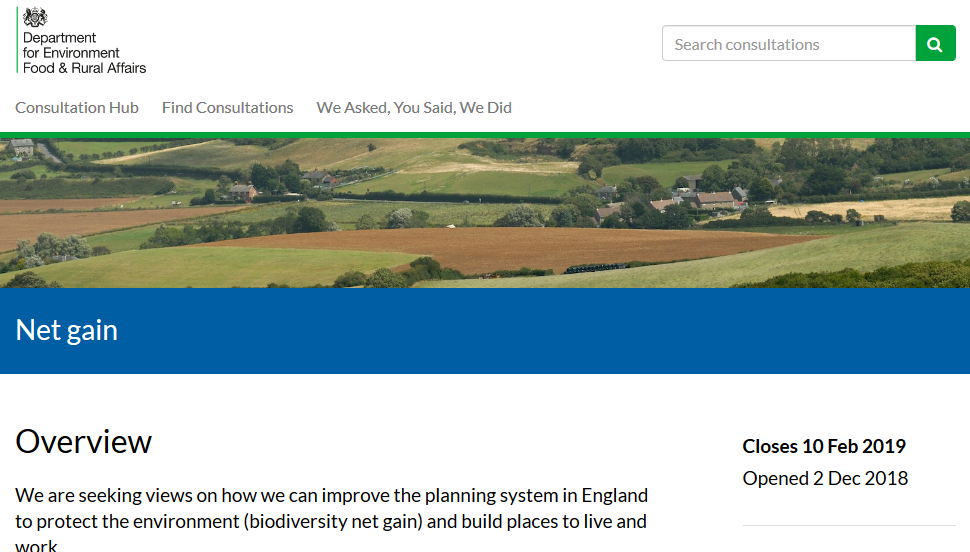
This consultation is a cut above the average – it’s on an important subject, with great implications, and it looks as if government is taking it very seriously. Or have I been fooled? I would welcome guest blogs on this subject from those with more knowledge than myself (a large number of folk!).
The idea: make compensation for biodiversity loss a necessary part of the planning process and make sure that the compensation results in net biodiversity gain.
Sounds good, doesn’t it? That compensation could be on-site, local or potentally at-a-distance. So the houses being built near me would lead to…?
This is a very serious matter, and if done well leads to a win-win-win-win- win situation for the environment, business, local residents and local and national governments.
I am inherently suspicious of the promise of biodiversity jam tomorrow in return for development now but I have an open mind if a good system could be evolved.
I’ve spent about an hour reading through the consultation this morning, and answering some of the questions, but I’ll have to come back to it – it’s quite meaty!
Here are some quotes from the consultation that raised my level of concern:
A stronger requirement to protect and enhance the environment through development could increase habitat for wildlife species.
https://consult.defra.gov.uk/land-use/net-gain/
The government will only mandate biodiversity net get if it is satisfied that it will deliver benefits for development, including greater certainty and process cost savings.
The approaches to net gain outlined in this consultation, including the Defra biodiversity metric, are based on habitat assessments and do not account for development impacts on individual species.
…we recognise that biodiversity is complex and that no single approach can fully guarantee net gains for biodiversity. There are, however, simple
and robust ways to measure the habitats that support biodiversity, and there are considerable benefits to mandating net gain through a single metric.
But this is an apparently thought-through consultation which contains real questions and plenty of information.
I’d be grateful for views from those engaging with its detail, and guest blogs would be very welcome.
Here’s the current biodiversity policy context concerning development in my neighbourhood (Hackbridge/Beddington Farmlands, South London). Our problem is not necessarily more policy but the need for enforcement and stronger challenge of anti-nature development. I think you are wise to suspect you have been fooled and I’d certainly be interested to hear any arguments why we should bother spending precious time responding to this consultation?
1.
Policy Context
a)
National Policy Context The National Planning Policy Framework 2018 (NPPF) favours sustainable development
including ‘helping to improve biodiversity (para. 8 c. pg 5) ,
‘minimising impacts on and providing net gains for biodiversity,’ (para. 170d. pg 49), ‘opportunities to incorporate
biodiversity improvement in and around developments should be encouraged (para 175d, pg 51, para 118, pg 28) and limit the impact on light
pollution…..on nature
conservation (para 180c pg 52). Furthermore circular 06/2005 Biological and Geological
Conservation states that ‘Developers should be required to undertake surveys where
there is a reasonable likelihood of the (protected) species being present and affected (para 99).
b)
Regional Policy Context:
i)
The London Plan 2016 contains relevant instructions which include sustainable development and design ..promoting biodiversity (Policy 5.3) integrating green infrastructure from the beginning of the design process (tree planting, green roofs, walls and soft landscaping) and major developments should be designed to deliver cooling aid, sustainable urban drainage, mitigation for climate change, enhancement of biodiversity and growing food( Policy 5.10 and Policy 5.11).
ii)
LDFs: Policy 7.19, Biodiversity and Access to Nature supports taking opportunities for positive gains for nature iii)
The proposed development is situated within The Wandle Valley Regional park which has a planning designation in the current London Plan, through the strategic spatial planning section and in reference to growth corridors. It is also given Supplementary Planning Guidance (SPG) as part of the All London Green Grid Framework, and features as ALGG Framework, Area 8. iv)
Furthermore the Mayor’s Biodiversity Strategy (GLA 2005) encourages new
development and landscaping which promotes biodiversity (pg 46) c)
Local Policy Context
i)
Sutton Local Plan 2016-2031 Policy 26 (which deals with biodiversity)
particularly relevant ‘the council will protect and enhance Sites of Importance
for Nature Conservation (SINC), Green Corridors and Biodiversity. It will ensure the restoration of Beddington Farmlands is completed to the agreed quality and implement its Biodiversity Action Plan and agri-
environment schemes’. Also ‘the council will grant permission for developments that create, conserve or
enhance biodiversity and improve access to nature’ and ‘the council will not
grant permission within or adjacent to a SINC where there would be damaging
impact on nature conservation value or integrity of the site’
Furthermore Policy 40 of the Local Plan states that the development area should
‘respect the open character of the adjacent Wandle Valley Region
al Park
’
. ii)
Building a Sustainable Sutton- The Local Plan Technical Guidance Note includes TGN 2 on Biodiversity accounting and TGN 3 on Green Space Factor relating to mitigation and enhancement of habitats.
iii)
The Hackbridge and Beddington Corner Neighbourhood Development Plan 2017-2027 contains policies promoting local biodiversity (see below section 2)